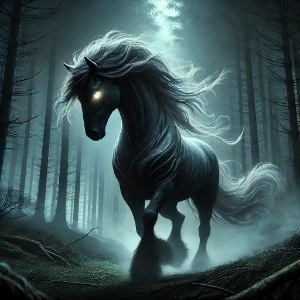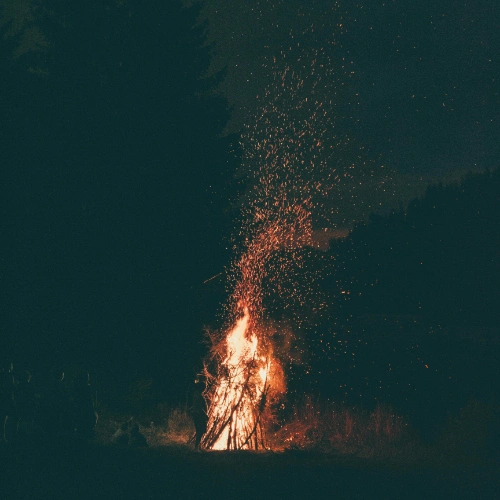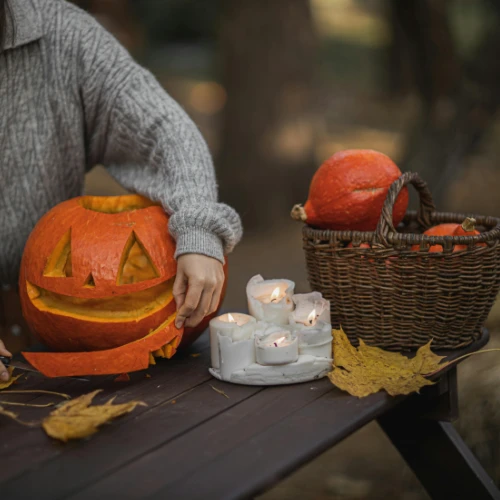What Is the Púca? Understanding the Trickster Spirit
Tales of mysterious creatures have been passed down through generations in Ireland’s misty hills and ancient forests. One of the most fascinating and mischievous figures in Irish folklore is the Púca.
A creature of many faces, the Púca is known for its shape-shifting abilities and playful yet sometimes dangerous nature.
The Púca can transform into various forms—most famously a wild, untamed horse with glowing eyes—but it’s also been seen as a goat, a rabbit, and even a human-like figure.
Its ability to change shape and appearance is one of the things that makes the Púca so unpredictable and hard to understand. Sometimes, it’s friendly and helpful, offering assistance or guiding travellers through the countryside.
Sometimes, it’s a trickster, leading people astray, causing confusion, or pulling pranks that can go too far.
This creature is not just a figment of fantasy—it’s a powerful symbol of the unpredictable forces of nature. The Púca embodies the idea that the world is a whole of hidden mysteries, where things are not always as they seem.
Whether it’s the shadow of the night or the fog over a lonely hill, the Púca reminds us that not all spirits are easy to understand. They may be mischievous, but they’re also a reminder that there’s magic in the world waiting to be discovered.
Table of Contents
What Is a Púca? The Basics of the Shape-Shifting Spirit
A Púca (pronounced “Pooka”) is a supernatural creature from Irish folklore. It is one of the many mysterious beings that inhabit the world of Irish mythology. Known for its shape-shifting abilities, the Púca can transform into different animals or even humans, depending on its mood or intentions.
The Púca appears as a wild, black horse with glowing eyes in its most famous form. This horse is often said to be untamed and challenging to ride, and it might even carry travellers on a dangerous or terrifying ride through the night.
But the Púca doesn’t always take the shape of a horse. Sometimes, it turns into a naughty goat, a rabbit, or even a human-like figure, making it hard to recognise.
In Irish mythology, the Púca is considered a type of spirit or fairy that exists between the worlds of the living and the dead. Its role in these stories is often that of a trickster.
The Púca has no fixed form, just as it has no fixed behaviour—it can be playful, helpful, or troublesome. It might lead a lost traveller to safety one moment, and the next, it could send them on a confusing, winding path through the woods.
The Púca’s ability to change shape and create chaos makes it fascinating and frightening. As a mythical creature of the night, it is often linked with mystery and the unknown. It is also connected with the natural world, especially the wild places—forests, hills, and fields—where the Púca is said to roam.
In many ways, the Púca represents the unpredictable side of nature, where things aren’t always as they appear and the boundaries between the ordinary and the magical blur.
In Irish folklore, the Púca plays a crucial role in reflecting the belief that the world is full of hidden, mysterious forces—some may be playful, while others can be pretty dangerous.
Common Forms of the Púca: From Horse to Human

One of the most fascinating things about the Púca is its ability to change shape. This shape-shifting nature means it can take on many different forms, each with its own personality and traits.
Here are some of the most common forms the Púca is said to take and how each reflects its mischievous, unpredictable nature:
The Wild Horse
The Púca’s most famous form is that of a wild, black horse with glowing eyes. This horse is untamed and challenging to control. In fact, many stories tell of people who try to ride the Púca only to be taken on a terrifying ride through the night.
The Púca in horse form is often seen as a creature of the wild, representing freedom, strength, and unpredictability. It’s a creature of the dark, appearing when the night is at its deepest, and it can lead travellers far from their intended path.
Sometimes, the ride ends with the person being thrown off, left disoriented and lost.
The Goat
In another common form, the Púca can appear as a goat. This form is usually smaller and more mischievous but no less tricky. Goats are often seen as stubborn and independent animals, and the Púca in goat form can be just as stubborn and hard to deal with.
It may wander into farmyards, causing trouble with livestock or crops. Some stories suggest that the Púca might lead a farmer’s sheep or cattle astray, causing confusion or chaos in the fields.
But sometimes, this form is linked to fertility and nature, as goats symbolise abundance and life.
The Rabbit
Sometimes, the Púca takes on the form of a rabbit, especially in areas where rabbits are common. Catching in this shape is quick, elusive, and more challenging. Rabbits move swiftly and often appear where least expected, much like the Púca.
In this form, the Púca can play pranks on people, darting in and out of sight, teasing them. The rabbit form represents the trickster side of the Púca—sly, fast, and always a step ahead of anyone who tries to catch it.
The Human
In some stories, the Púca can even take on a human form. When it does, it often appears as a dark, mysterious figure, sometimes with glowing eyes or strange, unsettling features.
It’s said that in human form, the Púca may try to deceive or trick travellers into trusting it, only to lead them into danger or confusion. While in human shape, the Púca can blend in with crowds, but there’s always something a little off about it. Its true nature often shines through in how it speaks or acts—awkwardly or with an air of mystery.
This form is less common than the animal shapes, but it still highlights the Púca’s ability to transform and manipulate.
Why Does the Púca Change Shape?
The different forms the Púca takes show how unpredictable and mysterious this creature is. Each form reflects a different aspect of its nature. Whether as a wild horse, a playful goat, a tricky rabbit, or a strange human, the Púca embodies change, freedom, and unpredictability.
It’s a reminder that nothing is fixed in Irish mythology and that the creatures of the Otherworld can never be fully understood or tamed.
Púca’s Mischievous Nature: Friend or Foe?
The Púca is famous for being a trickster—its behaviour is often playful but can also be harmful. It’s a creature that lives between friend and foe, sometimes helping and other times causing trouble. Its mischievous nature makes it both a fascinating and unpredictable figure in Irish folklore.
A Playful Trickster
In some stories, the Púca is not a danger but a playful creature that loves to have fun. It might lead a traveller on an unexpected adventure or play harmless pranks. For example, a Púca could befriend a lonely farmer, guiding them to a hidden treasure or showing them a shortcut through the forest.
In these moments, the Púca can seem almost friendly, even helpful. It’s like the creature is playing a game, testing the boundaries between reality and fantasy.
Sometimes, the Púca’s pranks are simple—like changing the direction of a traveller’s path or leading them to a different spot. In these cases, the Púca might not be trying to cause harm, just a little confusion for amusement’s sake.
People familiar with the creature’s tricks might laugh them off as harmless, part of the Púca’s playful nature.
The Dark Side: Harmful Mischief
But the Púca is not always so lighthearted. In some stories, its tricks can turn dangerous. As a shape-shifter, the Púca has the power to deceive people in ways that could cause harm.
One of the most common stories about the Púca is that it leads travellers astray. A person might think they are following a familiar path. Still, the Púca has changed their direction, sending them deeper into a dangerous or unfamiliar area.
This trickery can be frightening, especially if the traveller becomes lost or frightened in the wilderness.
In its horse form, the Púca is particularly dangerous. Travellers who try to ride the wild horse are often taken on a terrifying ride through the night.
The Púca may gallop through dark forests, rocky hills, or dangerous terrain. When the rider is thrown off, they may be miles away from where they started, confused and disoriented.
Leading People Astray
One of the Púca’s most well-known traits is its ability to lead people astray. It often plays tricks that cause confusion, making it hard for people to tell what’s real and what isn’t.
For example, a person walking through the forest might see what looks like a path ahead, only for the Púca to suddenly appear and change it, leading the person down a different trail. When the traveller realises they are lost, it’s too late.
In some stories, the Púca might pretend to be a friendly guide only to gain the traveller’s trust. It might pretend to know the way to a nearby village, only to lead them in circles.
This constant shifting of reality can make the Púca both frustrating and dangerous, especially for those who don’t understand its tricks.
The Púca’s Role as a Trickster
The Púca’s role as a trickster in folklore is significant. As a creature that shifts between good and evil, it represents the unpredictable nature of the world.
It’s neither wholly evil nor entirely reasonable but rather something in between. The Púca’s tricks serve as a reminder that things are not always as they seem and that life can be full of surprises—both pleasant and unpleasant.
In many ways, the Púca’s tricks reflect the unknown aspects of nature. It embodies the world’s wildness, where things can change instantly, and even the most familiar paths can lead to unexpected places.
Whether playing a harmless prank or leading someone into danger, the Púca’s unpredictable nature makes it one of Irish mythology’s most fascinating and mysterious creatures.
Púca and Samhain: The Connection to Halloween

In Irish mythology, the Púca is closely tied to Samhain. This ancient festival marks the beginning of winter and the end of the harvest season. Samhain (pronounced “sow-en”) is also the precursor to modern-day Halloween when the boundary between the living world and the spirit world is believed to be at its thinnest.
During Samhain, the Púca is considered especially active, making this time of year even more mysterious and full of potential mischief.
The Thinning of the Veil
Samhain was a time when people believed that the veil between the worlds of the living and the dead grew thin. This meant spirits and other supernatural creatures, like the Púca, could more easily cross over into the world of the living.
The night of Samhain, often celebrated on October 31st, was seen as a liminal time when the standard rules of the world didn’t apply. It was a time for magic, spirits, and encounters with creatures from the Otherworld.
During this time, people believed the Púca would be especially active, roaming the countryside, playing tricks, and leading travellers on wild, confusing paths. The Púca’s mischievous nature seemed to come alive under the cover of darkness, adding to Samhain’s eerie and mysterious atmosphere.
A Time of Trickery
Since Samhain was a time when spirits roamed freely, it was also when the Púca could be at its trickiest. People would be extra cautious during the nights of Samhain, aware that the Púca might be nearby, ready to lead them astray.
Sometimes, the Púca would take advantage of the celebratory mood, hiding in the shadows and causing confusion for those travelling from village to village. With the darkness of night and the uncertainty of the season, it was easy for the Púca to play its pranks.
In some stories, the Púca appears as a glowing, mischievous horse, leading people away from their homes or sending them on long, confusing journeys. It was believed that during Samhain, the Púca’s tricks could be more than harmless fun—they could be dangerous, causing people to get lost or even stumble into perilous situations.
The Role of the Púca During Samhain
The Púca’s connection to Samhain was also linked to the natural world. In the rural areas of Ireland, people often left offerings of food, drink, or other gifts to spirits during Samhain, hoping to gain their favour and protection for the coming winter months.
The Púca, with its strong connection to nature, might be one of the spirits that received such offerings.
Some people believed that the Púca, with its wild nature and shape-shifting powers, symbolised the world’s untamed forces. During Samhain, it was seen as a guardian of the old ways, a spirit that watched over the land as the seasons changed.
But while it could offer protection or guidance, the Púca was just as likely to lead someone astray or cause trouble—especially during this magical, unpredictable time.
Samhain and Modern Halloween

As Samhain evolved into the modern Halloween, the Púca’s association with the festival also carried over. Today, Halloween is still a time for spooky stories, costumes, and a sense of mystery.
The idea of creatures like the Púca lurking in the shadows and playing tricks has become a part of the traditions we still celebrate.
While the Púca may not roam the streets as it once did, its presence is still felt during Halloween. The idea of the thinning veil and the return of spirits from the Otherworld lives on in modern Halloween celebrations, keeping the spirit of mischief and mystery alive.
Just as people once feared the Púca during Samhain, we continue to embrace the thrill of the unknown during Halloween, remembering the legends and creatures that once roamed the earth.
In this way, the Púca’s connection to Samhain reminds us of the ancient belief in the power of the supernatural and the ever-present possibility of magic in the world, especially when the veil between the living and the dead is at its thinnest.
